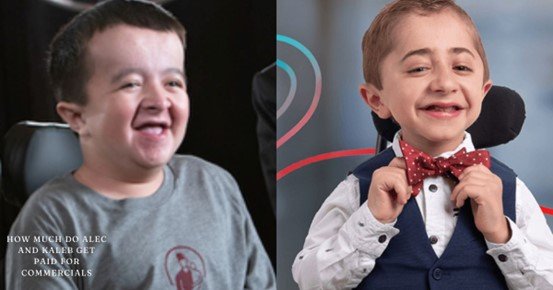Alec and Kaleb, the young spokesmen for Shriners Hospitals for Children, have become familiar faces in homes across the United States due to their heartfelt commercials and public appearances. Their charm, resilience, and personal stories have captured audiences and raised significant awareness for Shriners’ mission of providing free medical care to children. But with their rise in popularity, many people are curious about the potential earnings these young stars make for their work.
Understanding the Role of Child Actors in Commercials
Before delving into Alec and Kaleb’s specific roles, it’s essential to understand how child actors, especially those appearing in non-profit and hospital-related advertisements, are typically compensated. Children who appear in commercials are often part of union agreements that regulate their work hours, payment structure, and legal protections.
In Alec and Kaleb’s case, their roles as spokespersons for Shriners Hospitals add a unique dimension to their involvement, as Shriners is a non-profit organization. Child actors involved in charitable advertising campaigns can receive compensation, though it might differ significantly from what they might earn in traditional for-profit commercial settings.
How Much Do Alec and Kaleb Get Paid for Commercials?
Since Alec and Kaleb work for a non-profit organization, it’s unlikely their compensation follows the typical payment models seen in corporate commercials. Instead, it’s more plausible that their work falls under “stipend” or “honorarium” payment models that cover expenses rather than providing a large salary.
Factors Influencing Their Pay
Type of Commercial: Non-profit ads, like those for Shriners Hospitals, typically have smaller budgets and follow different compensation structures. Rather than traditional commercial rates, compensation for non-profit work often includes stipends, covering personal expenses and minimal payment for time and commitment.
Union Rules and Regulations: Actors who appear in commercials typically fall under Screen Actors Guild – American Federation of Television and Radio Artists (SAG-AFTRA) jurisdiction. SAG-AFTRA has specific rules on compensation, even for minors, though it’s unclear if Alec and Kaleb’s work for a non-profit organization adheres strictly to these rules.
Location and Filming Hours: Filming for Alec and Kaleb’s commercials may involve limited shooting days and follow child actor guidelines to avoid long hours on set, which would lower the overall costs.
Public Awareness and Fundraising Impact: Shriners’ campaigns have increased public awareness significantly, bringing greater attention to both the organization and its young spokespersons. While Shriners Hospitals likely see the value of their involvement, the increased visibility doesn’t necessarily equate to higher earnings for Alec and Kaleb themselves.
Industry Insights: Typical Child Actor Rates
For perspective, in the broader entertainment industry, the rates for child actors in commercials vary widely. Unionized actors typically receive around $500 to $2,000 per day for television commercials, with residuals based on the ad’s airing frequency and reach. However, Alec and Kaleb’s appearances are unlikely to be compensated at such high rates due to their non-profit association and the nature of Shriners’ work.
To maintain transparency and the ethical nature of non-profit commercials, Shriners may follow specific guidelines limiting their ability to compensate actors in a manner similar to corporate advertisers. This means their earnings would likely be much lower than typical industry rates.
How Non-Profit Advertising Differs from For-Profit Commercials
Non-profit organizations, including hospitals, often structure their advertising budgets carefully to prioritize donations towards their core services. Commercials for non-profits are generally meant to spread awareness and encourage donations rather than generate profit, which often results in limited budgets for on-screen talent.
Regulatory Compliance: Many non-profits adhere to transparency regulations and practices to maintain donor trust. By keeping Alec and Kaleb’s earnings modest, Shriners can demonstrate its focus on supporting its primary mission rather than heavily compensating spokespeople.
Estimated Earnings for Alec and Kaleb: Realistic Scenarios
How Much Do Alec and Kaleb Get Paid for Commercials?, Based on the available information and understanding of industry standards, we can infer Alec and Kaleb may earn stipends or hourly fees rather than substantial salaries. It’s possible they receive a few hundred dollars per appearance, and some non-profit organizations may even rely on volunteer participation.
Possible Payment Models:
Stipend-Based Model: Shriners might provide Alec and Kaleb with stipends for their appearances, covering expenses related to their time and any travel requirements. A stipend could range from $500 to $2,000, depending on the specific campaign and time commitment.
Hourly Fees with Capping: Some non-profit commercials pay hourly wages capped at a maximum amount to ensure fair compensation.
Non-Profit vs. For-Profit Commercial Compensation
Factor |
Non-Profit Commercials (Shriners) |
For-Profit Commercials |
| Compensation Rate | $20 – $50/hour (estimate) | $500 – $2,000 per day |
| Residuals | Unlikely | Often included based on airtime |
| Budget Prioritization | Patient Care/Service Focus | Profit and Marketing Focus |
| Talent Payment Transparency | High | Moderate |
| Budget Range for Talent | Limited | Broad, depending on ad reach |
Conclusion: How Much Do Alec and Kaleb Get Paid for Commercials
Alec and Kaleb’s roles as spokespeople for Shriners Hospitals for Children highlight the importance of child actors in spreading awareness and generating support for charitable causes. While their compensation might not mirror the rates seen in for-profit commercials, their work serves a more profound purpose: inspiring generosity and hope. The two boys have made a lasting impact by sharing their personal stories, becoming beloved figures, and furthering the mission of Shriners Hospitals to offer care regardless of financial constraints. For Alec and Kaleb, the rewards of their efforts likely go beyond financial gains, embodying a spirit of altruism and advocacy that resonates with viewers across the nation.
FAQs About How Much Do Alec and Kaleb Get Paid for Commercials
Are Alec and Kaleb paid the same as typical commercial actors?
No, it’s likely they are compensated differently. Since they are spokespersons for a non-profit organization, their compensation is probably lower than that of actors in traditional, for-profit commercials. They may receive stipends or modest hourly fees instead of high day rates and residuals.
Does Shriners provide Alec and Kaleb with a salary?
Shriners Hospitals likely pays Alec and Kaleb through a stipend or similar arrangement that covers expenses rather than a fixed salary. This method aligns with Shriners’ commitment to using donor funds responsibly.
Could Alec and Kaleb’s roles lead to future acting careers?
Absolutely! Alec and Kaleb have gained substantial exposure and experience in front of the camera, which could open doors for future roles. Child actors who gain popularity through charitable work often transition to professional acting careers if they choose to continue.
How much do typical child actors make for commercials outside of non-profit work?
For-profit commercials can pay child actors between $500 and $2,000 per day, with potential for residual earnings. However, Alec and Kaleb’s roles in Shriners’ commercials likely follow a different pay structure more in line with non-profit budgets.

